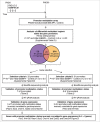DNA methylome changes by estradiol benzoate and bisphenol A links early-life environmental exposures to prostate cancer risk
- PMID: 27415467
- PMCID: PMC5048723
- DOI: 10.1080/15592294.2016.1208891
DNA methylome changes by estradiol benzoate and bisphenol A links early-life environmental exposures to prostate cancer risk
Abstract
Developmental exposure to endocrine-disrupting chemicals (EDCs), 17β-estradiol-3-benzoate (EB) and bisphenol A (BPA), increases susceptibility to prostate cancer (PCa) in rodent models. Here, we used the methylated-CpG island recovery assay (MIRA)-assisted genomic tiling and CpG island arrays to identify treatment-associated methylome changes in the postnatal day (PND)90 dorsal prostate tissues of Sprague-Dawley rats neonatally (PND1, 3, and 5) treated with 25 µg/pup or 2,500 µg EB/kg body weight (BW) or 0.1 µg BPA/pup or 10 µg BPA/kg BW. We identified 111 EB-associated and 86 BPA-associated genes, with 20 in common, that have significant differentially methylated regions. Pathway analysis revealed cancer as the top common disease pathway. Bisulfite sequencing validated the differential methylation patterns observed by array analysis in 15 identified candidate genes. The methylation status of 7 (Pitx3, Wnt10b, Paqr4, Sox2, Chst14, Tpd52, Creb3l4) of these 15 genes exhibited an inverse correlation with gene expression in tissue samples. Cell-based assays, using 5-aza-cytidine-treated normal (NbE-1) and cancerous (AIT) rat prostate cells, added evidence of DNA methylation-mediated gene expression of 6 genes (exception: Paqr4). Functional connectivity of these genes was linked to embryonic stem cell pluripotency. Furthermore, clustering analyses using the dataset from The Cancer Genome Atlas revealed that expression of this set of 7 genes was associated with recurrence-free survival of PCa patients. In conclusion, our study reveals that gene-specific promoter methylation changes, resulting from early-life EDC exposure in the rat, may serve as predictive epigenetic biomarkers of PCa recurrence, and raises the possibility that such exposure may impact human disease.
Keywords: Developmental origin of health and disease (DOHaD); Ingenuity®; NimbleGen rat DNA methylation promoter array; Pathway Analysis (IPA®); Sprague Dawley rats; The Cancer Genome Atlas (TCGA); early-life reprogramming; endocrine-disrupting chemicals (EDCs); epigenetics; methylated-CpG island recovery assay (MIRA); stem cell pluripotency.
Figures






Similar articles
-
Exposure of Human Prostaspheres to Bisphenol A Epigenetically Regulates SNORD Family Noncoding RNAs via Histone Modification.Endocrinology. 2015 Nov;156(11):3984-95. doi: 10.1210/en.2015-1067. Epub 2015 Aug 6. Endocrinology. 2015. PMID: 26248216 Free PMC article.
-
Prostate Cancer Risk and DNA Methylation Signatures in Aging Rats following Developmental BPA Exposure: A Dose-Response Analysis.Environ Health Perspect. 2017 Jul 11;125(7):077007. doi: 10.1289/EHP1050. Environ Health Perspect. 2017. PMID: 28728135 Free PMC article.
-
Gene expression and DNA methylation changes in the hypothalamus and hippocampus of adult rats developmentally exposed to bisphenol A or ethinyl estradiol: a CLARITY-BPA consortium study.Epigenetics. 2018;13(7):704-720. doi: 10.1080/15592294.2018.1497388. Epub 2018 Aug 15. Epigenetics. 2018. PMID: 30001178 Free PMC article.
-
Perinatal exposure to oestradiol and bisphenol A alters the prostate epigenome and increases susceptibility to carcinogenesis.Basic Clin Pharmacol Toxicol. 2008 Feb;102(2):134-8. doi: 10.1111/j.1742-7843.2007.00166.x. Basic Clin Pharmacol Toxicol. 2008. PMID: 18226066 Free PMC article. Review.
-
Sexually Dimorphic Effects of Early-Life Exposures to Endocrine Disruptors: Sex-Specific Epigenetic Reprogramming as a Potential Mechanism.Curr Environ Health Rep. 2017 Dec;4(4):426-438. doi: 10.1007/s40572-017-0170-z. Curr Environ Health Rep. 2017. PMID: 28980159 Free PMC article. Review.
Cited by
-
Untangling the association between environmental endocrine disruptive chemicals and the etiology of male genitourinary cancers.Biochem Pharmacol. 2020 Feb;172:113743. doi: 10.1016/j.bcp.2019.113743. Epub 2019 Dec 6. Biochem Pharmacol. 2020. PMID: 31812676 Free PMC article. Review.
-
PITX3 DNA methylation is an independent predictor of overall survival in patients with head and neck squamous cell carcinoma.Clin Epigenetics. 2017 Feb 2;9:12. doi: 10.1186/s13148-017-0317-7. eCollection 2017. Clin Epigenetics. 2017. PMID: 28174607 Free PMC article.
-
Potential Mechanisms of Bisphenol A (BPA) Contributing to Human Disease.Int J Mol Sci. 2020 Aug 11;21(16):5761. doi: 10.3390/ijms21165761. Int J Mol Sci. 2020. PMID: 32796699 Free PMC article. Review.
-
Decoding the Influence of Obesity on Prostate Cancer and Its Transgenerational Impact.Nutrients. 2023 Nov 21;15(23):4858. doi: 10.3390/nu15234858. Nutrients. 2023. PMID: 38068717 Free PMC article. Review.
-
Effects of perinatal exposure to bisphenol A on induction of prostate cancer in Sprague Dawley rats by MNU and testosterone.Toxicology. 2023 Jan 15;484:153394. doi: 10.1016/j.tox.2022.153394. Epub 2022 Dec 13. Toxicology. 2023. PMID: 36521576 Free PMC article.
References
-
- Rubin BS, Bisphenol A. an endocrine disruptor with widespread exposure and multiple effects. J Steroid Biochem Mol Biol 2011; 127:27-34; PMID:21605673; http://dx.doi.org/2649309310.1016/j.jsbmb.2011.05.002 - DOI - PubMed
-
- Seachrist DD, Bonk KW, Ho SM, Prins GS, Soto AM, Keri RA. A review of the carcinogenic potential of bisphenol A. Reprod Toxicol 2015; 59:167-82; PMID:26493093; http://dx.doi.org/10.1016/j.reprotox.2015.09.006 - DOI - PMC - PubMed
-
- Vandenberg LN, Maffini MV, Sonnenschein C, Rubin BS, Soto AM. Bisphenol-A and the great divide: a review of controversies in the field of endocrine disruption. EndocrRev 2009; 30:75-95; PMID:19074586; http://dx.doi.org/1817168710.1210/er.2008-0021 - DOI - PMC - PubMed
-
- Cavallaro M, Mariani J, Lancini C, Latorre E, Caccia R, Gullo F, Valotta M, DeBiasi S, Spinardi L, Ronchi A, et al.. Impaired generation of mature neurons by neural stem cells from hypomorphic Sox2 mutants. Development 2008; 135:541-57; PMID:18171687; http://dx.doi.org/10.1242/dev.010801 - DOI - PubMed
-
- Chen K, Fallen S, Abaan HO, Hayran M, Gonzalez C, Wodajo F, MacDonald T, Toretsky JA, Uren A. Wnt10b induces chemotaxis of osteosarcoma and correlates with reduced survival. Pediatric blood & cancer 2008; 51:349-55; PMID:18465804; http://dx.doi.org/10.1002/pbc.21595 - DOI - PubMed
Publication types
MeSH terms
Substances
Grants and funding
LinkOut - more resources
Full Text Sources
Other Literature Sources
Medical
